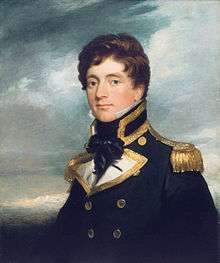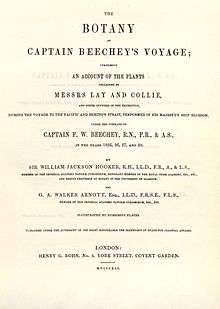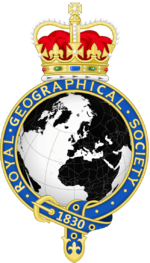Frederick William Beechey
| Frederick William Beechey | |
|---|---|
 | |
| Born |
17 February 1796 London |
| Died |
29 November 1856 (aged 60) London |
| Service/branch | Royal Navy |
| Years of service | 1806–1856 |
| Rank | rear-admiral |
| Commands held |
HMS Blossom Marine Department of the Board of Trade |
| Awards | president of the Royal Geographical Society |
Frederick William Beechey (17 February 1796 – 29 November 1856) was an English naval officer and geographer.
Career
He was the son of Sir William Beechey RA; and was born in London. In 1806, he entered the Royal Navy, saw active service during the wars with France and America. [1]
In 1818, he served under Lieutenant (afterwards Sir) John Franklin in David Buchan's Arctic expedition, of which at a later period he published a narrative. In the following year he accompanied Lieutenant W. E. Parry in HMS Hecla. In 1821, he took part in the survey of the Mediterranean coast of Africa under the direction of Captain, afterwards Admiral, William Henry Smyth. He and his brother Henry William Beechey, made an overland survey of this coast and published a full account of their work in 1828 under the title of Proceedings of the Expedition to Explore the Northern Coast of Africa from Tripoly Eastward in 1821-1822.[1]

In 1825, Beechey was appointed to command the HMS Blossom. His task was to explore the Bering Strait in concert with Franklin and Parry operating from the east. In the summer of 1826, he passed the strait and a barge from his ship reached 71°23'31" N., and 156°21'30" W. near Point Barrow which he named, a point only 146 miles west of that reached by Franklin's expedition from the Mackenzie river. The whole voyage lasted more than three years and in the course of it Beechey discovered several islands in the Pacific, and an excellent harbour near Cape Prince of Wales.[1]
In July 1826, he named the three islands in the Bering Strait. Two were the Diomede Islands that Vitus Bering had named in 1728: "Ratmanoff Island" (Big Diomede) and "Krusenstern Island" (Little Diomede). Beechey called the uninhabited third islet "Fairway Rock", which is still its contemporary name. One of his crew, Petty Officer John Bechervaise, gave a detailed account of the voyage in his Thirty Six Years if a Seafaring Life by an Old Quartermaster, published privately in 1839.
In 1831, there appeared his Narrative of a Voyage to the Pacific and Berings Strait to Co-operate with the Polar Expeditions, 1825-1828. In 1835, and the following year Captain Beechey was employed on the coast survey of South America, and from 1837 to 1847, carried on the same work along the Irish coasts. He was appointed in 1850 to preside over the Marine Department of the Board of Trade. [1]
In 1854, he was made rear-admiral, and in the following year was elected president of the Royal Geographical Society.[1]
Beechey Island, where Sir John Franklin wintered, is named after him.
Family
His daughter was the painter Frances Anne Hopkins who lived in Canada for twelve years and painted many scenes of canoe travel.
Three of his brothers were painters: the admiral and painter Richard Brydges Beechey, the portraitist Henry William Beechey, and the portraitist George Duncan Beechey.
See also
Publications
- — (1828). Proceedings Of The Expedition To Explore The Northern Coast Of Africa, From Tripoly Eastward; In MDCCCXXI and MDCCCXXII Comprehending An Account of The Greater Syrtis And Cyranaeica. London: John Murray. Retrieved 15 August 2009.
- — (1832). Narrative of A Voyage To The Pacific And Beering's Strait, To Co-Operate With The Polar Expeditions Performed In His Majesty's Ship Blossom, Under The Command Of Captain F. W. Beechey, R. N. In The Years 1825, 26, 27, 28. Philadelphia: Carey & Lea. Retrieved 15 August 2009.
- — (1843). A Voyage Of Discovery Towards The North Pole, Performed In His Majesty's Ships Dorothea And Trent, Under The Command Of Captain David Buchan, R. N., 1818. London: Richard Bentley. Retrieved 15 August 2009.
Notes
References
 This article incorporates text from a publication now in the public domain: Chisholm, Hugh, ed. (1911). "Beechey, Frederick William". Encyclopædia Britannica. 3 (11th ed.). Cambridge University Press.
This article incorporates text from a publication now in the public domain: Chisholm, Hugh, ed. (1911). "Beechey, Frederick William". Encyclopædia Britannica. 3 (11th ed.). Cambridge University Press. Laughton, John Knox (1885). "Beechey, Frederick William". In Stephen, Leslie. Dictionary of National Biography. 4. London: Smith, Elder & Co.
Laughton, John Knox (1885). "Beechey, Frederick William". In Stephen, Leslie. Dictionary of National Biography. 4. London: Smith, Elder & Co. - Laughton, J. K.; Lambert, Andrew. "Beechey, Frederick William (1796–1856)". Oxford Dictionary of National Biography (online ed.). Oxford University Press. doi:10.1093/ref:odnb/1946. (Subscription or UK public library membership required.)
- Narrative of a voyage... 1825-28, by Captain F.W. Beechey, London, 1831, Page 337
External links
- Biography at the Dictionary of Canadian Biography Online
- View digitized titles related to Frederick William Beechey in Botanicus.org
- Hooker, Sir William Jackson; G. A. Walker Arnott, Esq. (1841). The Botany of Captain Beechey's voyage. Henry George Bohn.
